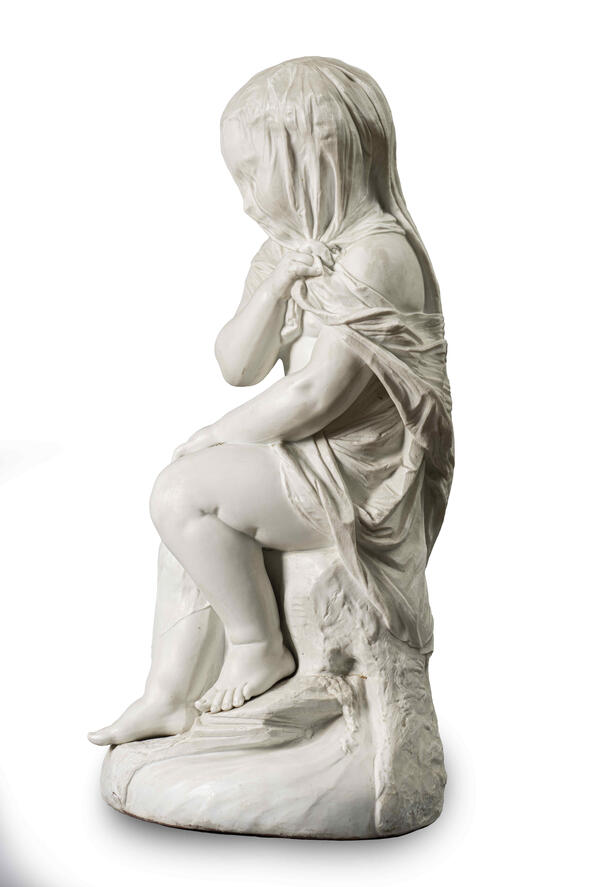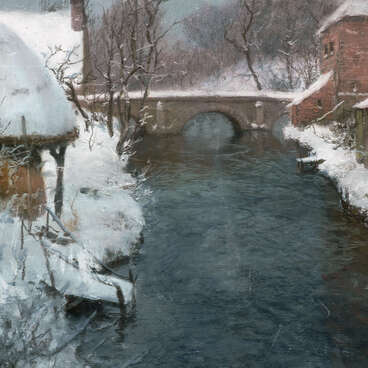The figurine of a young girl under a veil from the studio of the Parisian ceramic sculptor Gille Jeune, was modeled in biscuit porcelain by Charles Baury (1827–1879) in the mid-19th century. The material takes its name from the French biscuit — “dry bread”, “dry biscuit” and from the Latin bis — “baked twice”. This is a hard type of ceramics, which is ideal for interior items, decorations and sculptural compositions.
The peculiarity of this material is that it is fired twice, without covering with glaze. The surface of such products becomes white, matte and slightly rough, which gives it a marble-like look. The porous structure of biscuit is not particularly suitable for making tableware, but it still can be used for small statuary.
The first firing at the temperature of 800–1000 °C is quite slow, which prevents the evaporating water from deforming the work in any way. During this process, irreversible chemical and physical changes occur in the material, resulting in a durable product.
The fashion for biscuit porcelain dates back to the mid-18th century in connection with the spread of the ideas of neoclassicism in Western European and Russian art.
When Gille Jeune died, his manufactory was taken over by Charles Baury and renamed “Villon & Baury”. It produced sculptural series in biscuit porcelain, such as “The Seasons” and “The Natural Elements”. The figurine from the museum collection, which has a general, descriptive name “The Veiled Girl”, is similar to “The Night”, kept in the Tsaritsyno Museum-Reserve.
The figurine, made of biscuit porcelain, features a two or three-year-old girl, sitting with her eyes closed. Her head is covered with the finest veil. She holds the edges of the cloth with both hands, revealing to the viewer the limitless possibilities of the material which seems ideally suitable for modeling the chubby figures of small children and their delicate skin.
Charles Baury masterfully captures the lovely details of a child’s body. The rippling folds of the light veil covering the girl’s face and part of her right leg contrast with the smooth, glossy skin, and the dimples on her chubby elbows and knees. Through the elaborately molded fine transparent fabric, falling in multiple folds, one can see clearly a beautiful face and closed eyes.
The peculiarity of this material is that it is fired twice, without covering with glaze. The surface of such products becomes white, matte and slightly rough, which gives it a marble-like look. The porous structure of biscuit is not particularly suitable for making tableware, but it still can be used for small statuary.
The first firing at the temperature of 800–1000 °C is quite slow, which prevents the evaporating water from deforming the work in any way. During this process, irreversible chemical and physical changes occur in the material, resulting in a durable product.
The fashion for biscuit porcelain dates back to the mid-18th century in connection with the spread of the ideas of neoclassicism in Western European and Russian art.
When Gille Jeune died, his manufactory was taken over by Charles Baury and renamed “Villon & Baury”. It produced sculptural series in biscuit porcelain, such as “The Seasons” and “The Natural Elements”. The figurine from the museum collection, which has a general, descriptive name “The Veiled Girl”, is similar to “The Night”, kept in the Tsaritsyno Museum-Reserve.
The figurine, made of biscuit porcelain, features a two or three-year-old girl, sitting with her eyes closed. Her head is covered with the finest veil. She holds the edges of the cloth with both hands, revealing to the viewer the limitless possibilities of the material which seems ideally suitable for modeling the chubby figures of small children and their delicate skin.
Charles Baury masterfully captures the lovely details of a child’s body. The rippling folds of the light veil covering the girl’s face and part of her right leg contrast with the smooth, glossy skin, and the dimples on her chubby elbows and knees. Through the elaborately molded fine transparent fabric, falling in multiple folds, one can see clearly a beautiful face and closed eyes.




